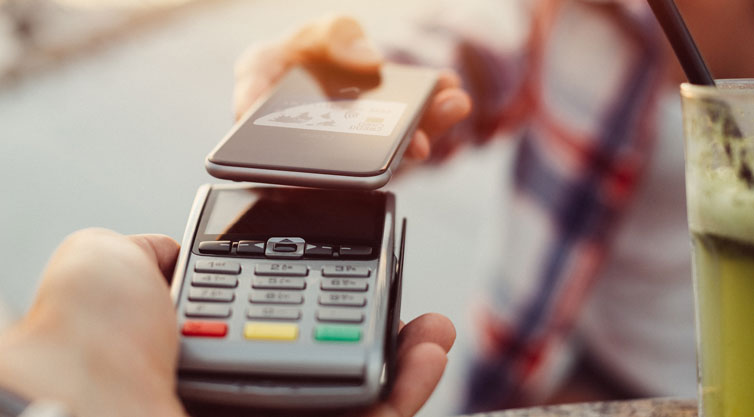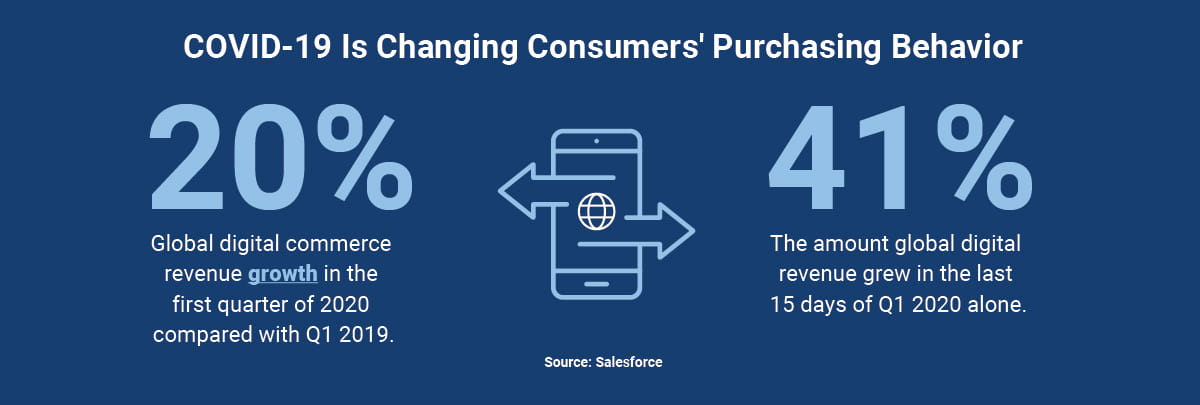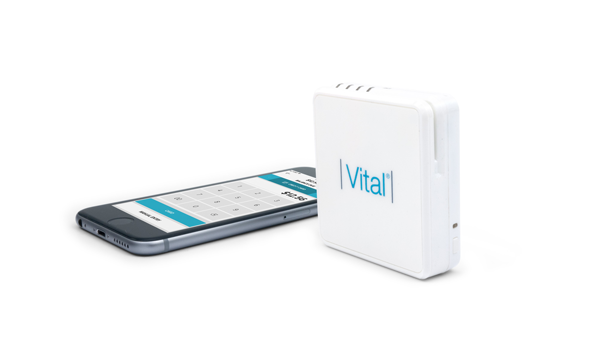Content provided by TSYS A Global Payments Company
by: Cameron Bready

The coming weeks hold plenty of uncertainty as the world reels from the coronavirus pandemic, but some experts are already thinking about how the current crisis will impact society for years to come. At Global Payments, we see the global economic trends, refracted through the lens of payments and commerce, and it tells a story of change and the need to prepare for a variety of possible futures.
One is the transition from brick and mortar to ecommerce. The numbers support this seismic shift. Global digital commerce revenue experienced 20% growth in the first quarter of 2020 compared with Q1 2019. The last 15 days of the quarter alone saw a 41% spike in activity.
COVID-19 consumer behavior reshapes payment trends
Underneath that macroeconomic view, we are starting to see the pandemic shift some consumer behaviors. About 30% of U.S. consumers have begun using contactless payments — NFC cards, smartphones and wearables — since widespread concern about the virus began to impact the U.S., according to a survey conducted March 20 through March 23 by RTi Research. About three in 10 are “extremely” or “very worried” about catching the virus from cash, and 22% are concerned about paying by card, the firm noted. As such, there is a significant move away from transactions requiring any contact including with pen, pads and the passing of cards and cash to transactions that require no-contact.
There’s also evidence that many of these new behaviors will remain after “business as usual” resumes. Of the new contactless users, 70% said they would continue to use these methods after the pandemic has subsided, according to RTi. And the networks are laying the groundwork for this: Mastercard, for example, has recently announced permanent raises on contactless transaction limits around the world, such as Canada, the Middle East, and Africa. Canada’s limit is now $250 in Canadian dollars.

Looking toward recovery
As the economy rebounds, we anticipate an acceleration of new payment trends. For example, worldwide, we see the pandemic fueling the push by countries toward cashless societies. Valdis Dombrovskis, the European Commission’s vice president for financial services, tweeted on March 26: “Time to swap your coins for payment cards – safer for containing #coronavirus.” In Asia, Narendra Modi, India’s prime minister, has encouraged the use of digital payments during the pandemic. Kyash, a Japanese-based digital wallet provider, raised $45 million recently to help Japan convert to a cashless economy. South Korea’s central bank said in early March it would aim to take all banknotes out of circulation for two weeks, and would burn some of the bills to reduce the spread of the virus. In Africa, the government of Kenya has been encouraging citizens to use cashless transactions, such as M-Pesa, the country’s vastly popular money transfer system.
Drilling down to some individual sectors that have been affected, below are some of our insights on how they are managing – and how things might be different going forward:
![]()
*Restaurants. Since March 1, the industry has lost more than 3 million jobs and $25 billion in sales, according to an estimate by the National Restaurant Association. Many restaurants have pivoted to accept online orders and grab and go. Restaurants are finding new ways to manage their cash flow, such as encouraging the purchase of gift cards and other incentives that can be redeemed at a future date. Shelter in place is cause for operators to find cost-effective ways to enhance their ordering systems, moving to a cloud-based solution that offers needed customer engagement and marketing capabilities to stay engaged with customers who no longer are coming onsite.
![]()
*Financial Institutions. With consumers doing all they can to avoid physical contact, issuing contactless payment cards is becoming more of a priority for banks. Whereas in a pre-COVID world, the end consumer didn’t necessarily mind swiping or inserting a card to pay, these days waving their card over a point-of-sale device is not only preferred but necessary for public health reasons. Even before the coronavirus outbreak, TSYS, a Global Payments company, saw 28% year-over-year growth for contactless in 2019 and expects even more accelerated growth as the pandemic unfolds.
And with much economic hardship for consumers and businesses, issuers will see credit lines extended to the limit. Experts agree that higher loan losses are just around the corner, so many banks are taking a long-term view of working with customers by implementing loan repayment freezes and emphasizing options like installments for unexpected purchases. In the midst of new social distancing requirements, digital banking services will become even more of a focus, with financial institutions driving consumers to mobile apps, online payments and other self-service options. Many banks are also getting creative with handling the increased volume at their call centers by repurposing office space, introducing home-based work arrangements and other flexible strategies.
At Global Payments, we see the global economic trends, refracted through the lens of payments and commerce, and it tells a story of change, and the need to prepare for a variety of possible futures.
![]()
*Retail. With the exception of essential services such as grocers, pharmacies and discount stores, brick and mortar retailers are looking for short-term revenue strategies. For example, Pier1, who filed for bankruptcy in February, has asked the bankruptcy court to allow it to skip rent payments during the COVID-19 pandemic. All of this is forcing brick-and-mortar retailers to focus more effort on ecommerce.
Going forward, they will shift more of their business to the internet and the cloud. Payment partners that offer robust ecommerce offerings will be critical, given that there are so many consumer preferences on ways to pay. And analytics capabilities that optimize cart conversions and minimize customer disputes will be an essential component of their platforms.
![]()
*Education. With most college and K-12 schools having shut down under state or county orders, online education now has become front and center. On the one hand, the format is nothing new, with many universities having embraced it years ago, setting up their own platforms, or making their classes available through online programs. But the scale of nearly an entire nation needing to learn at home has taken time to implement, with issues such as bandwidth, security and privacy bringing new challenges teachers and administrators.
Yet after the pandemic, when in-person classes resume, look for a greater portion of students to demand online education. About 85% of students who have experienced both formats said learning online is “as good or better” than attending courses in person. And given this newfound fluidity between online and offline learning, payments will follow suit. The ability to accept tuition and fee payments online will increase.
![]()
*Nonprofits. About 73% of nonprofits have canceled a fundraising event due to COVID-19, resulting in a cumulative loss in the second quarter of $644 million, according to a survey of 331 organizations by Community Health Charities, a nonprofit focused on health and well being. The spring is the gala season for many nonprofits, so the timing of the pandemic makes fundraising especially difficult.
These organizations are using several tactics to continue their missions: shifting once in-person events to virtual settings, asking for ticketholders to donate the funds as a gift, and cutting some services. Longer term, there’s the possibility of relying more on virtual events. Look for a robust event software platform, which allows you to fundraise from anywhere at any time. Software should allow you to conduct online bidding, accept a wide range of payments and raise funds through continuous, open-ended campaigns.
While so many sectors are struggling during these unprecedented times, there will also be opportunities as this pandemic moves businesses out of their respective comfort zones and away from the old ways of doing things. Moving forward, it’s the companies that are able to quickly adapt that will be best positioned to navigate this challenge and others as they arise.
We’ve weathered storms before in our over half a century of payments experience and have made investments in our payments infrastructure and solutions to ensure we are steadfast in helping our customers make the necessary shifts to connect with their customers at every point of commerce. Through this pandemic and unforeseeable hurdles in the future, our team at Global Payments will be here alongside you to help you chart the course in whatever comes next.
Read the original TSYS article here.
Questions? TSYS Can Help
NFIB and TSYS have teamed up to offer members access to fast, secure, and simple payment solutions for their businesses. Learn More>>


